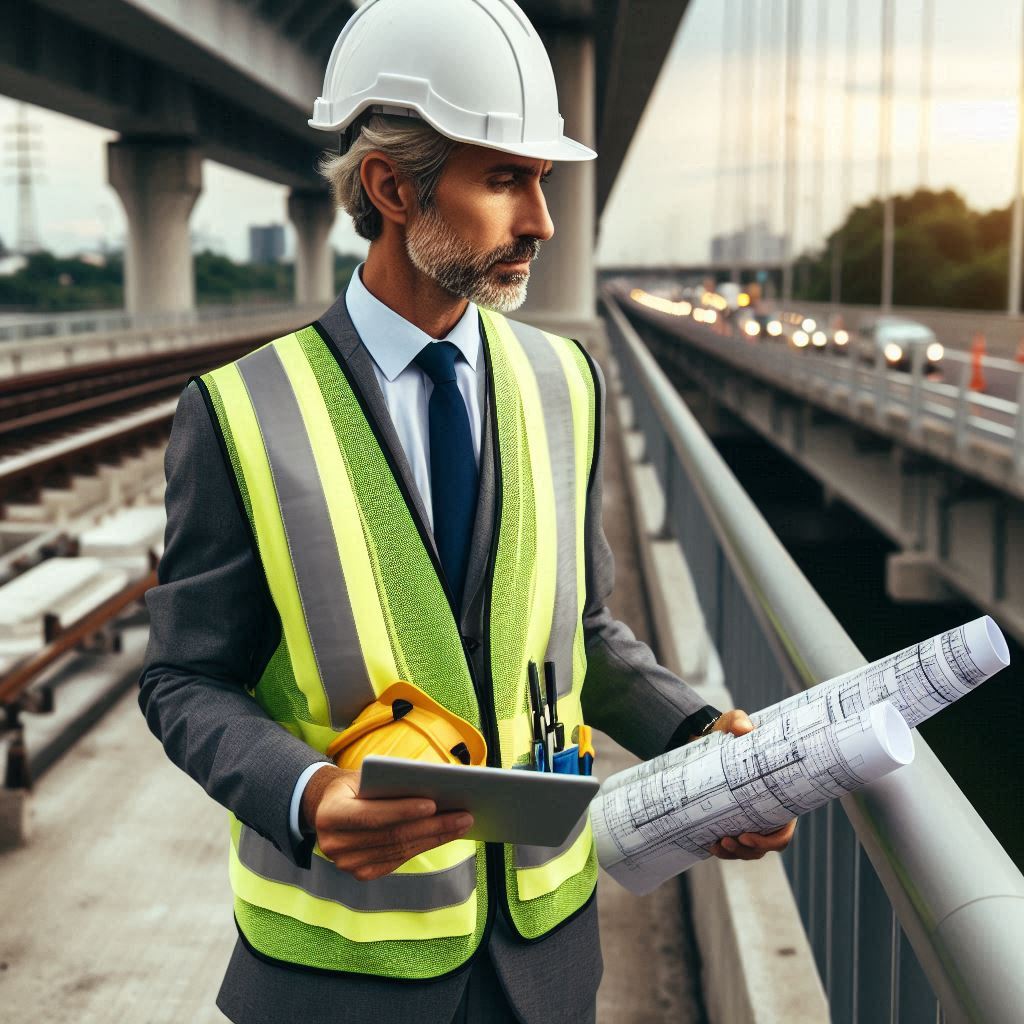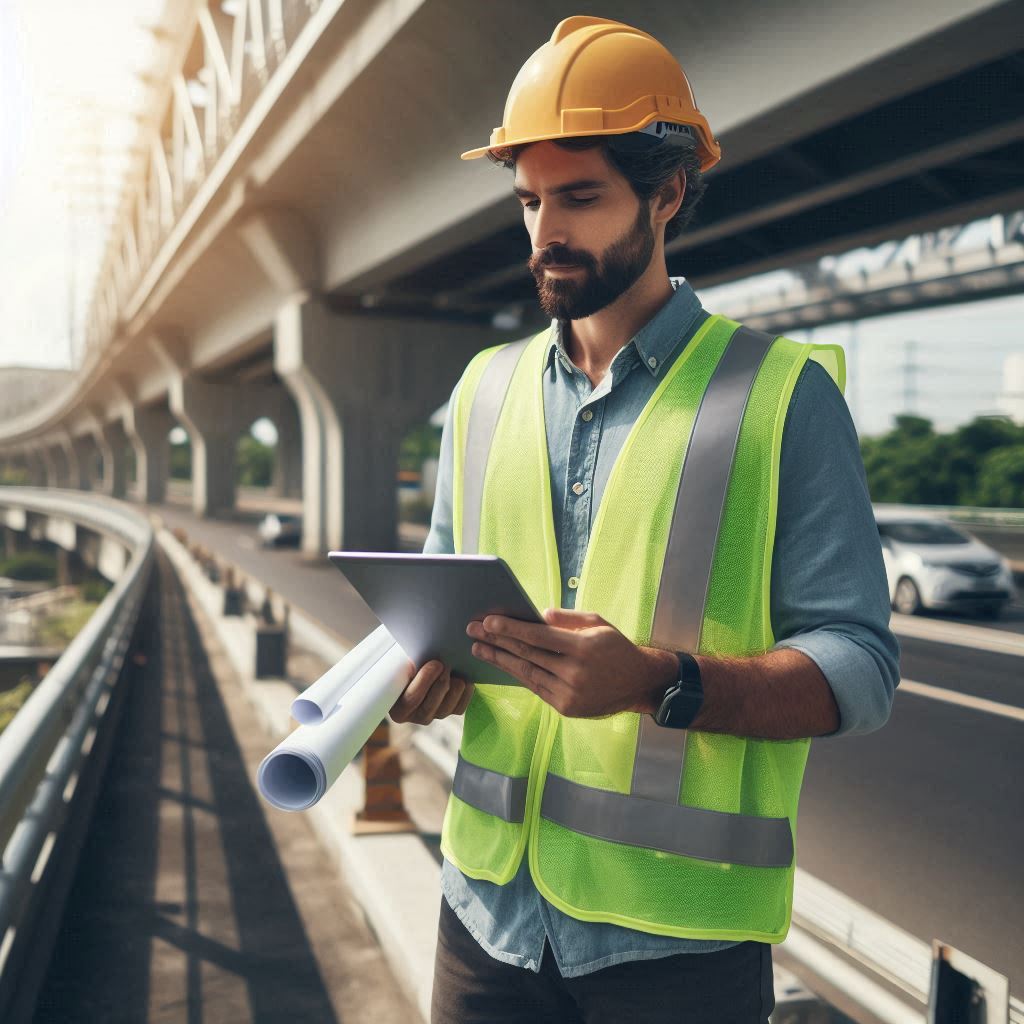Introduction
Transportation engineering involves the application of technology and scientific principles to design efficient and safe transportation systems.
It focuses on planning, designing, and implementing infrastructure to move people and goods from one place to another.
The importance of transportation engineering in society cannot be overstated.
It plays a crucial role in promoting economic growth, improving quality of life, and enhancing safety.
Transportation systems impact various aspects of our daily lives, including commuting, logistics, and travel.
Real-World Applications
One real-world application of transportation engineering is the design of traffic signal systems.
Engineers analyze traffic patterns, optimize signal timing, and implement intelligent technologies to improve traffic flow and reduce congestion in urban areas.
Roadway design is another essential application of transportation engineering.
Engineers use advanced tools and techniques to develop roadways that are safe, durable, and efficient.
Factors such as lane width, curve radius, and grade are carefully considered to ensure the smooth flow of traffic.
Transportation engineers also play a critical role in public transportation planning.
They design bus routes, determine optimal locations for bus stops, and analyze ridership data to improve the overall efficiency and accessibility of public transit systems.
Another significant application is the design of bike lanes and pedestrian pathways.
Transportation engineers strive to create infrastructure that accommodates non-motorized modes of transportation, promoting sustainability, reducing greenhouse gas emissions, and enhancing overall mobility for cyclists and pedestrians.
Overall, transportation engineering is essential for developing safe, efficient, and sustainable transportation systems that meet the evolving needs of society.
By applying innovative solutions and technologies, transportation engineers continue to shape the way we move and connect with the world.
Urban Planning
- Transportation engineers play a crucial role in designing efficient transportation networks in cities.
- They analyze traffic patterns, population density, and future growth to create optimal solutions.
- By incorporating public feedback and data-driven insights, engineers can develop plans that improve overall mobility.
Examples of successful urban planning projects
- The revitalization of downtown areas through pedestrian-friendly streets and bike lanes.
- The implementation of bus rapid transit systems to decrease congestion and enhance accessibility.
- The development of multi-modal transportation hubs that connect different modes of transportation seamlessly.
Impact on traffic flow and public transportation systems
- Efficient transportation networks improve traffic flow and reduce travel times for commuters.
- Well-designed public transportation systems increase ridership and decrease reliance on private vehicles.
- By prioritizing sustainable modes of transportation, cities can reduce carbon emissions and improve air quality.
Overall, transportation engineering plays a vital role in shaping the future of urban planning.
By designing efficient transportation networks, implementing innovative solutions, and prioritizing sustainable transportation options, engineers can create more livable, accessible, and environmentally-friendly cities.
Through collaborative efforts with city planners, policymakers, and communities, transportation engineers can continue to make significant contributions to urban development and improve the quality of life for residents.
Read: The Role of Aerospace Engineers in Satellite Development
Road Safety
Role of Transportation Engineers in Ensuring Road Safety
Transportation engineers play a crucial role in ensuring road safety.
They analyze traffic patterns, design safe roadways, and implement safety measures.
Their work involves assessing potential hazards and finding solutions to minimize accidents.
Engineers carefully consider road layouts, signage, and pedestrian crossings to prevent collisions.
They collaborate with urban planners and local authorities to integrate safety into transportation systems.
By prioritizing safety in their designs, transportation engineers help reduce the risk of accidents and save lives on the road.
Implementation of Traffic Management Techniques and Technologies
Effective traffic management is key to road safety, and transportation engineers lead this effort.
They use advanced technologies and strategies to control traffic flow, reduce congestion, and prevent accidents.
Engineers implement traffic signals, roundabouts, and speed limits based on thorough analysis.
They also incorporate intelligent transportation systems (ITS) that use sensors, cameras, and real-time data to monitor and manage traffic.
These systems allow for dynamic adjustments to traffic conditions, such as altering signal timings during peak hours.
Additionally, engineers use road markings, barriers, and warning systems to guide drivers and prevent accidents.
Case Studies of Road Safety Improvements Through Engineering Solutions
Several case studies highlight the impact of engineering on road safety.
One example is the redesign of a dangerous intersection in New York City.
Engineers implemented a roundabout, improved signage, and added pedestrian islands.
These changes reduced accidents by over 50% in the first year.
Another case is the use of ITS in Los Angeles, where engineers installed traffic cameras and sensors to monitor road conditions.
The system alerted drivers to potential hazards and adjusted traffic signals to improve flow.
This led to a significant decrease in traffic accidents.
In Sweden, the Vision Zero initiative is another example, where transportation engineers aimed to eliminate all traffic fatalities.
They redesigned roads, improved lighting, and added barriers to separate different types of traffic.
As a result, Sweden now has one of the lowest traffic fatality rates in the world.
Transportation engineers are vital to creating safer roads through strategic design and advanced technologies.
Their work has a direct impact on reducing accidents and saving lives.
By continuously innovating and applying best practices, engineers ensure that road safety remains a top priority.
Read: Aerospace Engineering in Commercial Spaceflight
Public Transportation Systems
Public transportation systems are vital components of urban infrastructure, providing efficient and sustainable mobility for millions of people.
Effective transportation engineering is essential to designing and optimizing these systems, improving accessibility, and enhancing sustainability.
Designing and Optimizing Bus, Train, and Subway Systems
Designing and optimizing bus, train, and subway systems require a thorough understanding of urban dynamics.
Transportation engineers analyze traffic patterns, population density, and commuter needs to create efficient routes and schedules.
By optimizing the flow of buses, trains, and subways, engineers can reduce travel times, minimize congestion, and enhance the overall passenger experience.
For example, advanced software tools allow engineers to model different scenarios, helping them make informed decisions about route planning and scheduling.
This process ensures that public transportation systems operate smoothly, meeting the demands of growing urban populations.
Improving Accessibility and Sustainability of Public Transportation
Improving accessibility and sustainability are crucial goals in modern public transportation systems.
Transportation engineers focus on making public transit accessible to everyone, including people with disabilities.
This includes designing stations, vehicles, and infrastructure that accommodate wheelchair users, the elderly, and others with mobility challenges.
Engineers also work to enhance the sustainability of public transportation by incorporating eco-friendly technologies.
Electric buses, energy-efficient trains, and renewable energy sources contribute to reducing the environmental impact of public transit.
Additionally, engineers explore ways to integrate public transportation with other sustainable modes, like cycling and walking, to promote a greener urban environment.
Benefits of Efficient Public Transportation Networks
Efficient public transportation networks offer numerous benefits for cities and their residents.
First, they reduce traffic congestion by providing a reliable alternative to private vehicles.
Fewer cars on the road lead to less traffic, shorter commutes, and improved air quality.
Second, public transportation networks contribute to economic growth by connecting people to jobs, education, and services.
Well-designed transit systems can revitalize neighborhoods, attract businesses, and increase property values.
Third, public transportation enhances social equity by providing affordable mobility options for everyone, regardless of income level.
Access to reliable transit helps bridge the gap between different socioeconomic groups, promoting inclusivity and social cohesion.
Lastly, efficient public transportation supports public health by encouraging physical activity.
Walking to and from transit stops increases daily exercise, contributing to healthier lifestyles.
In a nutshell, transportation engineering plays a pivotal role in designing and optimizing public transportation systems.
By improving accessibility and sustainability, engineers create transit networks that benefit cities and their residents.
Efficient public transportation is not just a convenience; it is a critical element of sustainable urban development, offering social, economic, and environmental advantages.
Investing in the design and optimization of public transportation systems is essential for the future of our cities.
Read: Essential Aerospace Engineering Textbooks

Traffic Management
One crucial aspect of transportation engineering is traffic management, which involves the utilization of various strategies to optimize traffic flow and reduce congestion.
Utilization of Traffic Signal Optimization and Intelligent Transportation Systems
One effective way to manage traffic is through the use of traffic signal optimization.
By adjusting the timing of traffic signals based on real-time traffic data, engineers can ensure smoother traffic flow and reduce delays.
Intelligent Transportation Systems (ITS) also play a significant role in traffic management.
These systems incorporate technologies such as sensors, cameras, and communication networks to gather traffic information and make real-time decisions to improve traffic flow and safety.
Improving Traffic Flow and Reducing Congestion
The ultimate goal of traffic management is to improve traffic flow and reduce congestion on roadways.
By implementing strategies like traffic signal coordination, lane control systems, and dynamic message signs, engineers can effectively manage traffic flow to prevent bottlenecks.
Additionally, the use of ramp metering, variable speed limits, and adaptive traffic control systems can help smooth traffic flow and reduce congestion on highways and freeways.
Case Studies Demonstrating the Effectiveness of Traffic Management Strategies
There are numerous case studies that highlight the effectiveness of traffic management strategies in improving traffic flow and reducing congestion.
For example, a study conducted on the implementation of adaptive traffic signal control in a city demonstrated a significant reduction in travel times and delays for motorists.
Another case study focused on the use of ramp metering on a congested highway, which resulted in a smoother traffic flow and reduced the number of accidents caused by merging vehicles.
Overall, these case studies illustrate the tangible benefits of implementing traffic management strategies in real-world applications, showcasing the positive impact that transportation engineering can have on improving the efficiency and safety of transportation systems.
Read: Exploring Subfields of Aerospace Engineering
Transform Your Career Today
Unlock a personalized career strategy that drives real results. Get tailored advice and a roadmap designed just for you.
Start NowInfrastructure Development
Infrastructure development plays a crucial role in transportation engineering.
It involves the process of designing, constructing, and maintaining various elements that make up the transportation network.
This includes roads, bridges, highways, tunnels, airports, and public transit systems.
Designing, building, and maintaining roads, bridges, and highways
One of the primary responsibilities of transportation engineers is to plan and design the layout of roads, bridges, and highways.
They consider factors such as traffic flow, safety, and environmental impact when creating these infrastructure elements.
Once the design is finalized, construction begins, and engineers oversee the building process to ensure that the infrastructure is built according to specifications.
Regular maintenance is also crucial to keep these structures in optimal condition and ensure the safety of the traveling public.
Incorporating sustainability and resilience in infrastructure projects
With the increasing focus on sustainable development, transportation engineers are tasked with designing infrastructure projects that minimize environmental impact and promote long-term sustainability.
This includes using eco-friendly materials, implementing energy-efficient technologies, and incorporating green spaces into transportation systems.
Engineers also work on making infrastructure more resilient to natural disasters and other unforeseen events to ensure the continuity of transportation services even in challenging situations.
Examples of innovative infrastructure developments in transportation engineering
There are several notable examples of innovative infrastructure projects in transportation engineering that have revolutionized the way people travel.
One such example is the construction of high-speed rail networks in countries like Japan, France, and China, which have significantly reduced travel times between major cities.
Another example is the development of smart highways equipped with sensors and communication technologies that provide real-time traffic information to drivers and help improve traffic flow and safety.
Additionally, advancements in bridge design, such as the construction of cable-stayed and suspension bridges, have enabled engineers to build structures that are more resilient and visually appealing.
In essence, infrastructure development is a critical aspect of transportation engineering that involves the planning, design, construction, and maintenance of various transportation elements.
By incorporating sustainability and resilience principles into infrastructure projects and implementing innovative solutions, transportation engineers play a vital role in shaping the future of transportation systems and improving the overall quality of transportation services.
Environmental Impact
Transportation engineering plays a crucial role in shaping the modern world, but it also significantly affects the environment.
Engineers must address the environmental impact of their projects, ensuring that infrastructure development does not come at the expense of the planet.
By considering factors like air and water pollution, noise levels, and habitat disruption, transportation engineers can create designs that balance human needs with environmental preservation.
The growing awareness of climate change and environmental degradation has pushed the field towards more sustainable practices, making it essential for engineers to prioritize environmental concerns in all transportation projects.
Addressing Environmental Concerns in Transportation Engineering Projects
Transportation engineering projects often require significant land use and resource consumption, leading to potential environmental damage.
To mitigate these impacts, engineers must conduct thorough environmental impact assessments (EIAs) before starting any project.
These assessments help identify potential environmental risks and provide strategies to minimize them.
For instance, engineers can design roads that avoid critical wildlife habitats or implement noise barriers to protect residential areas.
Additionally, using materials with lower environmental footprints, such as recycled asphalt or concrete, can reduce the overall impact of construction.
Addressing these environmental concerns early in the planning process is vital for ensuring that transportation projects do not harm the natural world.
Implementing Sustainable Transportation Solutions
Sustainable transportation solutions are becoming increasingly important as cities grow and traffic congestion worsens.
Engineers must focus on developing transportation systems that meet current needs without compromising future generations.
One approach is to promote public transportation, which reduces the number of vehicles on the road and decreases overall emissions.
Another is to design infrastructure that supports non-motorized transport, such as cycling and walking.
Implementing smart traffic management systems that optimize traffic flow and reduce idling times can also significantly lower emissions.
By integrating these sustainable solutions, transportation engineers can help create cleaner, more efficient cities that are better equipped to handle the challenges of the future.
Importance of Reducing Carbon Emissions and Promoting Eco-Friendly Transportation Options
Reducing carbon emissions is a primary goal of modern transportation engineering.
The transportation sector is one of the largest contributors to greenhouse gas emissions, making it crucial for engineers to develop strategies that lower these emissions.
Promoting eco-friendly transportation options, such as electric vehicles (EVs), is one way to achieve this.
Engineers can design infrastructure that supports EVs, such as charging stations, to encourage their adoption.
Additionally, expanding public transportation networks and improving fuel efficiency in traditional vehicles can further reduce carbon footprints.
By focusing on reducing carbon emissions and promoting eco-friendly options, transportation engineers can play a key role in combating climate change and protecting the environment.
Uncover the Details: Engineering Technician: Pros and Cons of the Career
Freight Transportation
In the realm of transportation engineering, one key focus is on designing and implementing efficient logistics and freight transportation networks.
These systems are crucial for the movement of goods and materials that drive our global economy.
Let’s delve into the various aspects and real-world applications of freight transportation within the field of transportation engineering.
Designing Efficient Logistics and Freight Transportation Networks
When it comes to designing efficient logistics and freight transportation networks, transportation engineers play a vital role in optimizing the flow of goods from producers to consumers.
They consider factors like distance, mode of transport, time, cost, and environmental impact to come up with the most effective solutions.
By strategically planning routes, modes of transport, and storage facilities, transportation engineers ensure that goods reach their destinations in a timely and cost-effective manner.
They use advanced technologies and modeling techniques to analyze different scenarios and identify the most efficient transportation routes.
By identifying potential bottlenecks and inefficiencies in the system, transportation engineers can recommend improvements that streamline operations and enhance overall productivity.
Additionally, they work closely with stakeholders to address their specific needs and requirements, ensuring that the logistics and freight transportation networks are tailored to meet their unique challenges.
Impact of Transportation Engineering on Supply Chain Management
The field of transportation engineering has a direct impact on supply chain management by providing the infrastructure and systems needed to facilitate the seamless movement of goods throughout the supply chain.
By optimizing transportation routes and modes, transportation engineers help businesses reduce lead times, lower costs, minimize stockouts, and improve overall supply chain efficiency.
They also play a crucial role in enhancing visibility and traceability within the supply chain, allowing businesses to track the movement of goods in real-time and respond quickly to any disruptions or delays.
By incorporating advanced technologies like GPS tracking, RFID, and real-time data analytics, transportation engineers enable businesses to make data-driven decisions that optimize their supply chain operations and improve customer satisfaction.
Case Studies of Successful Freight Transportation Projects
Several successful freight transportation projects serve as shining examples of the positive impact of transportation engineering on logistics and supply chain management.
One such case study is the Panama Canal Expansion project, which involved the construction of new locks and channels to accommodate larger container ships.
This expansion increased the canal’s capacity, allowing for more efficient transportation of goods between the Atlantic and Pacific oceans.
Another notable example is the High-Speed Rail project in Japan, which revolutionized passenger and freight transportation by significantly reducing travel times and increasing capacity.
These projects demonstrate the transformative power of transportation engineering in improving the efficiency, reliability, and sustainability of freight transportation systems.
Overall, freight transportation is a critical component of the global economy, and transportation engineering plays a crucial role in designing, optimizing, and managing the logistics and supply chain networks that support it.
By leveraging advanced technologies, innovative solutions, and strategic planning, transportation engineers continue to drive improvements in freight transportation systems, ultimately benefiting businesses, consumers, and economies worldwide.
Explore Further: Best Practices for Database Monitoring and Maintenance
Future Trends and Challenges
As transportation engineering continues to evolve, several emerging technologies are shaping the future of the field.
These advancements are not only improving the efficiency and safety of transportation systems but also presenting new challenges that need to be addressed.
Emerging technologies in transportation engineering
- Connected and autonomous vehicles (CAVs) are revolutionizing the way we think about transportation. These vehicles have the potential to reduce traffic congestion, improve road safety, and enhance the overall travel experience.
- Electric vehicles (EVs) are gaining popularity as more people become concerned about the environmental impact of traditional gasoline-powered cars. EVs are more energy-efficient and emit fewer greenhouse gases.
- High-speed rail systems are being developed in various parts of the world to provide fast and efficient transportation between major cities. These systems have the potential to reduce the dependence on air travel and lower carbon emissions.
- Advanced traffic management systems use real-time data and analytics to optimize traffic flow, reduce congestion, and improve overall road safety. These systems can detect traffic incidents, adjust signal timings, and provide information to drivers about the best routes to take.
Addressing challenges such as autonomous vehicles and climate change
While emerging technologies offer exciting possibilities for transportation engineering, they also present significant challenges that need to be addressed.
Autonomous vehicles, for example, raise questions about liability, safety, and ethical considerations.
As these vehicles become more prevalent on the road, engineers need to develop new regulations and standards to ensure their safe operation.
Climate change is another pressing issue that transportation engineers are working to address.
The transportation sector is a significant contributor to greenhouse gas emissions, so finding sustainable solutions is crucial.
This includes promoting the use of public transportation, developing clean energy sources, and designing more fuel-efficient vehicles.
Importance of continuous innovation and adaptation in the field
To meet the evolving needs of society, transportation engineers must embrace continuous innovation and adaptation.
This means staying current with the latest technologies, trends, and best practices in the field.
By fostering a culture of creativity and experimentation, engineers can develop new solutions to complex transportation challenges.
Moreover, collaboration with other disciplines such as urban planning, architecture, and environmental science is essential for creating integrated and sustainable transportation systems.
By working together, experts from different fields can leverage their unique expertise to design efficient, safe, and environmentally friendly transportation networks.
In review, the future of transportation engineering is filled with possibilities and challenges.
By embracing emerging technologies, addressing complex issues like autonomous vehicles and climate change, and fostering a culture of innovation and collaboration, transportation engineers can help shape a more sustainable and efficient transportation system for future generations.
Uncover the Details: Case Studies: Successful Systems Engineering Projects
Conclusion
Recap of Key Points Discussed in the Blog Post
Transportation engineering is a field that significantly impacts daily life.
From designing roads and highways to optimizing public transit systems, transportation engineers solve real-world problems.
They use advanced technologies to improve traffic flow, reduce accidents, and enhance mobility.
Additionally, transportation engineering contributes to environmental sustainability by promoting energy-efficient transport solutions.
It‘s a field that combines technology, science, and innovation to meet the growing demands of modern society.
Each application discussed shows the vital role transportation engineering plays in improving how we travel and interact with our environment.
Transform Your Career Today
Unlock a personalized career strategy that drives real results. Get tailored advice and a roadmap designed just for you.
Start NowEmphasis on the Significance of Transportation Engineering in Shaping Modern Society
Transportation engineering shapes modern society by making our daily commutes safer and more efficient.
Through innovative designs and strategic planning, transportation engineers reduce congestion and improve road safety.
They also contribute to economic growth by ensuring that goods and services are transported efficiently.
Furthermore, transportation engineering supports environmental goals by developing sustainable transport systems.
These contributions are crucial in a world that relies heavily on mobility.
The work of transportation engineers ensures that cities function smoothly, enabling us to connect, work, and thrive in our communities.
Call to Action for Further Exploration of Transportation Engineering Applications in the Real World
Transportation engineering offers endless opportunities for innovation and improvement.
The real-world applications discussed are just the beginning of what this field can achieve.
As technology advances, transportation engineers will continue to find new ways to enhance our mobility and safety.
This field is critical in addressing future challenges, such as urbanization and climate change.
For those interested in making a difference, exploring transportation engineering further could lead to exciting opportunities.
Whether through academic research or practical application, there is much more to discover and contribute in this vital field.
[E-Books for Sale]
The Big Book of 500 High-Paying Jobs in America: Unlock Your Earning Potential
$19.99 • 500 High-Paying Jobs • 330 pages
Explore 500 high-paying jobs in America and learn how to boost your career, earn more, and achieve success!
See All 500 High-Paying Jobs of this E-Book
1001 Professions Without a Degree: High-Paying American Jobs You Can Start Now
$19.99 • 1001 Professions Without a Degree • 174 pages
Discover 1001 high-paying jobs without a degree! Unlock career tips, skills, and success strategies for just $19.99!




